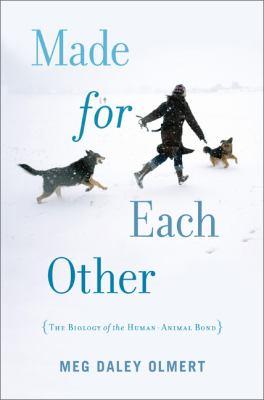
Made for each other : the biology of the human-animal bond
Available Copies by Location
| Location | |
|---|---|
| Victoria | Available |
Browse Related Items
| Subject |
| Human-animal relationships. |
- ISBN: 9780306817366
- Physical Description xix, 291 pages
- Publisher Cambridge : Da Capo Press, 2008.
Content descriptions
| General Note: | "A Merloyd Lawrence Book." |
| Bibliography, etc. Note: | Includes bibliographical references and index. |
Additional Information

CHOICE_Magazine Review
Made for Each Other : The Biology of the Human-Animal Bond
CHOICE
Copyright American Library Association, used with permission.
In this engagingly written volume, science writer Olmert presents an interesting hypothesis: that our relationships with animals are mediated via the hormone oxytocin, which is responsible for the bonds that humans and animals have formed throughout history. In support of her hypothesis, Olmert draws on wide-ranging sources from fields as diverse as history, anthropology, literature, philosophy, psychology, and biology. The book is written in a pleasant, easy-to-read style that makes complex data understandable for general readers. Unfortunately, scientifically minded readers will probably have difficulty with the author's imprecise language and her selective presentation and discussion of evidence. Does oxytocin explain everything? Almost certainly not, but one would not know it from reading this book, since Olmert attempts to link oxytocin (or oxytocin deprivation) to such a wide range of human behaviors. This is a "feel good" book about human-animal relationships. Although humans undoubtedly benefit in many ways from interacting with animals, keeping animals as pets, and working with domesticated animals, the relationship between humans and animals is ultimately far more complicated--and more interesting--than the simple picture Olmert paints. Summing Up: Recommended. General readers. S. C. Baker James Madison University

Kirkus Review
Made for Each Other : The Biology of the Human-Animal Bond
Kirkus Reviews
Copyright (c) Kirkus Reviews, used with permission.
TV documentary producer Olmert examines an important hormonal element in the health-giving ties of affection between humans and animals. "Long before animals were practical, they were fascinating," she writes. "Long before we wanted to eat them or ride them, we wanted to paint them and touch them." It's our natural sense of biophiliathe biological urge to connect, our ancient attraction to other creatures. A raft of contemporary scientific inquiries has identified the hormone oxytocin as a prime mover in the strong feelings of attraction, recognition and commitment between mammals, and it's also an essential genetic ingredient bonding parent with child. What is oxytocin's gift? It makes us feel good by relaxing both our physiological and psychological climates; it calms and quiets as it heightens our receptivity and awareness. Olmert has a lively voice, but she's unarguably sensible as she tracks the known effects of oxytocin release. It happens when we earnestly watch an animal go about its daily routine and the living world reveals itself. Making successful physical contact increases well-being on both sides, as the animal releases oxytocin as well. Olmert explores a variety of engagements, from paralanguages (grunts, coos, growls) to the seat-bone communication between horse and rider. She only rarely takes flights into fancy, as when she speaks of the "vague, mutual sense of recognition" that flowed between man and wolf some 400,000 years ago. She also offers some intriguing digressions, such as the role oxytocin could potentially play in understanding aspects of autism and attention-deficit disorder. A warm exploration of the bond that might just keep humans sane "until our own species can settle down again and act civilized." Copyright Kirkus Reviews, used with permission.

BookList Review
Made for Each Other : The Biology of the Human-Animal Bond
Booklist
From Booklist, Copyright (c) American Library Association. Used with permission.
Many people will attest to the happiness pets bring, but few are aware of the neurochemical basis. In one of those delectably synergistic books that tie together threads of science, history, and everyday life, Olmert explains the evolutionary processes behind what E. O. Wilson calls biophilia, our love and need for animals. The complex story begins with the hormone oxytocin. First identified as the agent for labor contractions and breast-feeding, oxytocin is now recognized as the biological factor in social bonding. Olmert tracks the far-reaching power of oxytocin back to our Ice Age ancestors' transformation into hunters, the forging of communities, and the welcoming of wolves around the hearth. As wolves evolved into dogs, it is oxytocin that turned them into man's best friend, and the same mutually beneficial oxytocin-enhancing chemistry makes possible the close bonds between humans and horses, cattle, and cats. Studies proving the remarkable therapeutic effects of pets bolster Olmert's mind-stretching assertion that our close relationships with other species are organically necessary for our well-being. More proof of the astonishing intricacy of life's interconnectivity.--Seaman, Donna Copyright 2009 Booklist


